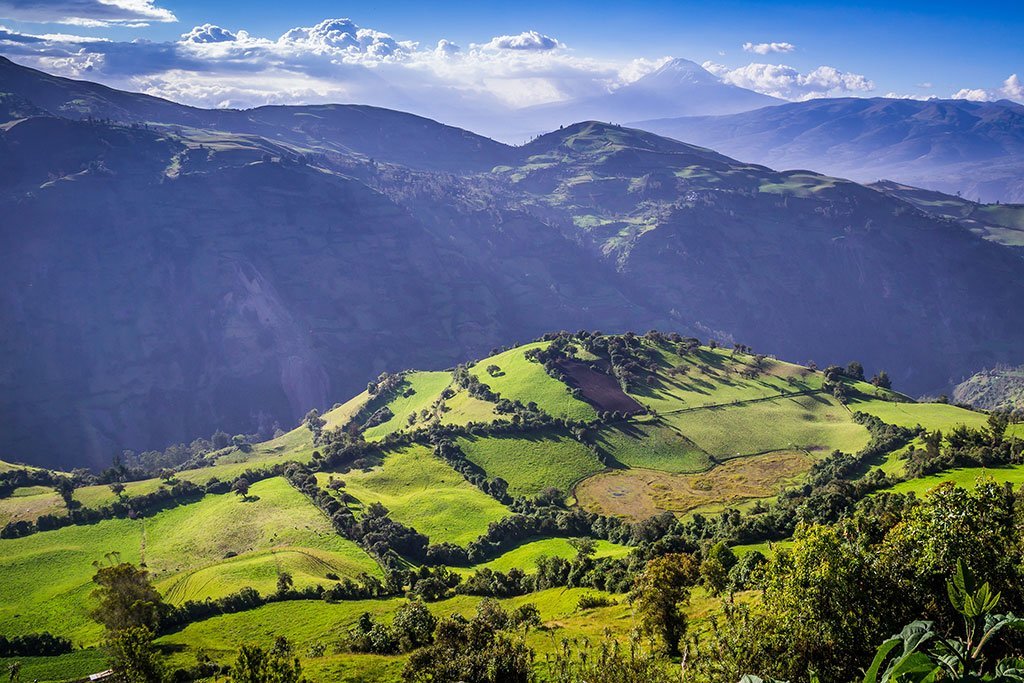ANDES
The paramos surrounding Ecuador's volcanoes are perfect for hiking, horseback riding, llama trekking, camping and mountain biking. With Safari you can combine a fun filled active day with an excellent dinner and comfortable night at one of the historic hostals or haciendas reating your own fantasy holiday.
Ecuador is home to a variety of colourful Indian groups. The Otavalo and Salasacas Indians continue the 500-year old weaving practices of their ancestors, creating incredible handicrafts. Safari brings you into their villages and homes to see these age-old techniques.The Cayambe Caranques fiestas of Inti-Raymi and the Octavas (located high in the Andes and exactly at the equator) celebrate the great cultural significance of the passing of the sun. With Safari you are part of the party.Running the length of Ecuador and splitting the country into two from north to south the mountains and valleys of the High Andes form the heart of Ecuador. The Pan American road runs down the inter-Andean valley from the border with Colombia at Tulcan, to Loja, south of Cuenca where it turns west to the coast to cross the Peruvian border at Huaquillas.


Quito, the capital is located at 2900m in a valley on the western slopes of the Pichincha volcano, and there are several cities and towns to visit and stay at as one travels north and south in the highlands.Sadly the old railway service is limited to a once a week excursion on Sundays from Quito to Boliche, a service on Saturdays from Quito toRiobamba, and three times a week an excursion from Riobamba,down the Devil’s Nose and then back up again. There is no service from Riobamba to Quito and the service from Ibarra to San Lorenzo has been suspended. There are many hot and mineral springs, the most famous at Papallacta, 2 hours east of Quito and at Baños 4 hours to the south. There are also Hot Springs in Baños and near Cuenca.Prior to the arrival of the Spanish in 1534, the Incas ruled the Andes for about 50 years from 1480, there legacy being the quechua language, still spoken as a first language by more than half of the population. The area is still home to a number of indigenous peoples, from the Cañaris, north of Cuenca to the black communities of the Chota valley in the north. The most famous are the Otavaleños. Bought here by the Cusceñous (Incas) at the end of the 15th century or early in the 16th century, the Otavalenians have maintained their own identity while successfully integrating into the modern economy. Their strength is their love of textiles, expressed in their weavings, coupled with a sharp business sense, that has led the young men and women of this nation to travel all over the globe selling their weaving and other artisan products from Ecuador. The peaks of the Andes are as distinct as the people. Cotopaxi (5987meters) the highest active volcano in the world has an almost perfect conical shape, as does the Sangay (5500meters), with major volcanic events taking place as frequently as every 15 minutes! In both cordilleras you will find remote areas, with excellent opportunities for adventure


Contact Us
Location Name
Quito - Ecuador
Head Office
Address: Av. Del Establo N25-33 Phone: +593 2 3670120 USA & Canada: (305)600-5732 e-mail: admin@safari.com.ec whatsapp: +593 996807207 QUITO - ECUADOR
Support
equadoradventure@gmail.com